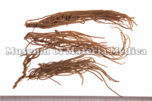Asiasarum Root

|
Market name:細辛 Photo location:Museum of Materia Medica, Inst. of Nat. Med. TMPW No.:3401 |

|
Plant name:Asiasarum heterotropoides Photo location:Toyama Pref., Japan Photo date:2001 Photographer:K. Komatsu |
| Synonym | Manchurian Wildginger |
| Latin name | Asiasari Radix |
| Botanical source: Family name | Aristolochiaceae |
| Botanical source: Plant name | - Asiasarum heterotropoides var. mandshuricum F.Maekawa - Asiasarum sieboldii F.Maekawa (IPNI:93597-1) |
| Part used | Root with rhizome |
| Empirical criteria for quality selection | Good one has strong odor and pungency. (TN) |
| Constituents | Fatty acids: A. heterotropoides var. seoulense: Parmitic acid Monoterpenoids: A. sieboldii: Eucarvone, Limonene, 1,8-Cineole, 3-Caren-2-on-5-ol, 2-Epoxycaran-2-on-3-ol; A. heterotropoides var. seoulense: l-β-Pinene, Eucarvone Phenylpropanoids: A. sieboldii: Methyleugenol, Elemicin; A. heterotropoides var. seoulense: Methyleugenol, Safrole, Kakuol; A. heterotropoides var. mandshuricum: Kakuol Lignans & Neolignans: Asatone; A. sieboldii: l-Asarinin; A. heterotropoides var. seoulense: l-Sesamin Isoquinoline alkaloids: A. heterotropoides var. mandshuricum: Higenamine Capsaicins: A. heterotropoides var. mandshuricum: Pellitorine, 2E,4E,8Z,10E,-N-Isobutyl-2,4,8,10-dodecatetraenamide, 2E,4E,8Z,10Z-N-Isobutyl-2,4,8,10-dodecatetraenamide |
| Pharmacological effects | Antiinflammatory, antihistaminic (water extract), sedative, antipyretic, analgesic (essential oil). |
| Indications | As an antitussive, expectorant, tranquilizer, painkiller and metabolic promoter, it is applied to treat cough with thin sputum due to chronic bronhcitis and bronchiectasis, frequent cough with headahe, chest pain and a feeling of fullness in the chest. |
| Diseases | Cough, Chronic bronchitis, Bronchiectasis, Headache, Nasal obstruction, Sinusitis, Dyspnea, Somatic pain, Swelling and pain of joint, Toothache, Chill, Common cold |
| Formulas | keikyososooshimbuto , shakkan'oshimbuto , shoseiryuto , shoseiryutokakyoninsekko , shoseiryutokasekko , jingyokyokatsuto , seijokentsuto , sekigan , daiobushito , tokishigyakukagoshuyushokyoto , tokishigyakuto , maobushisaishinto , meiroin , yakanmaoto , rikkosan , ryokankyomishingeninto |
| Meridian tropism | Heart, Lung, Liver, Kidney |
| Property | Warm |
| Flavor | Acrid/pungent |
| Classification in "Shen-non Ben-cao Jing" | Superior |
| TCM: Classification | Diaphoretics |
| TCM: Medicinal effects | To remove wind and cold, to relieve nasal obstruction, to alleviate pain and to remove retained fluid. Used for common cold, headache, toothache, sinusitis with nasal obstruction, rheumatic arthralgia, cough and dyspnea due to retention of phlegm and fluid. |
| Remarks | Listed in the Japanese Pharmacopoeia 18th ed. |
| References | TN: T. Namba & Y. Tsuda ed., Outline of Pharmacognosy, a Textbook, 3rd ed., Nankodo Co., Ltd., Tokyo, 1998. |
DNA sequences of medicinal plants
| Gene Region | |||||||||||||||||||
| Nuclear | Chloroplast | Mitochondria | |||||||||||||||||
| Botanical source: Plant name | 5Ss | 18S | ITS1 | 5.8S | ITS2 | 26S | others | trnH-psbA | matK | trnK | trnK-rps16 | trnT-L | trnL | trnL-F | rbcL | rpoC1 | ndhF | others | |
|
|
|||||||||||||||||||
|
|
|||||||||||||||||||
|
|
|||||||||||||||||||
